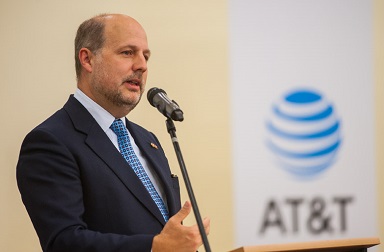Well, this week’s themes are BIG. Fundamental flaws in chip security are affecting all kinds of IoT devices, and big players like Intel and Apple are in the frame as they scramble to patch the problem. ‘Does the IoT have the device management tools needed to fix this?’ asks Jeremy Cowan. One analyst doubts it.
Meanwhile, planners are asking if smart cities will be fit for purpose. Will they be smart enough to provide help where it’s needed most – for the elderly? (In planners’ timefames, that’s you and me, by the way.) It’s not a coincidence that we’re seeing a growing focus on edge computing for smart cities – in some IoT sectors that may be the only way to manage all this data.
As you will have heard unless you just got in from Mars, Google‘s Project Zero security research team has released details of a serious security vulnerability. Indeed, some are calling it the most serious hardware bug of the modern era.

Samuel Hale, analyst and IoT development expert at the US-based analyst firm MachNation tells IoT Now: “This vulnerability impacts literally all large cloud-services companies like Google, Amazon, Microsoft, IBM and others that offer multi-tenant services.”
So, he believes it’s no wonder that Intel’s stock tumbled following this announcement. Fixing this security problem is going to decrease enterprise application performance by approximately 10-15% worldwide. “This vulnerability is so serious,” says Hale, “that any application running on a system may be able to access normally off-limits data, such as passwords, security keys, or other sensitive information.”
He insists the implications for Internet of Things devices will be huge. “The majority of all IoT devices worldwide will need a software update very soon. Without great IoT device management, this is going to be extremely difficult to accomplish.”

Gavin Millard, technical director at Tenable adds: “The latest vulnerabilities blessed with catchy names and logos are deserving of the hype that will surely build. Spectre and Meltdown are both incredibly concerning from a privacy perspective, affecting the average home user and enterprises alike.
The long-standing blunder in chip design could enable an attacker to access confidential pieces of information being processed, for example grabbing a password as it’s typed, installing malware that could slurp up anything a user is working on, or browser data to enable it to hoover up credit card details and logins.” (Other vacuum cleaners are available. Ed.)
“For home users, MacOS has already been updated to address the flaw with Apple’s recent 10.13.2 patch release. For Windows, there were also fixes made available last night. Almost everybody is affected by these bugs, in ways researchers are only just discovering. It is of the utmost importance that updates are applied in a timely manner,” says Millard. “With a possible decrease in processing speed caused by addressing the flaws, organisations that rely on cloud platforms could be facing a significant financial impact from the increase in the number of workloads required to complete tasks.”
Creating a city for all
We’ll come back to the cloud vs. edge debate, but first I want to touch on the impact of smart cities. According to John Vladimir Slamecka, region president, EMEA at US network operator AT&T. Cities must adapt to the needs of the growing ageing population. In particular, he is focusing on the changing nature of our cities, how technology can help them adapt their existing infrastructure, and the trends we can expect to see from cities leading the ‘smart race’.

It’s a fact, the world is getting older. The World Health Organisation (WHO) says the number of people who live to 60 years of age will more than double between 2015 and 2050. That’s an increase from 900 million to more than 2 billion people.
They will also be living in older cities. So, says Slamecka, the combination of aching knees and a crumbling infrastructure could prove costly from an economic and social perspective a few years down the line.
The answer lies in smart cities – ones that use technology to get more from their existing infrastructure. They can improve the lives of citizens, especially those in ageing communities or people living with disabilities. A truly smart city can give them, “the tools to go on living independently for longer and the community support they need. It offers a host of benefits from economic, health, quality of life, housing services, and emergency services.”
He believes that simple things will make the quality of life much easier for older folks. An automated service can turn on the radio without fiddling with awkward knobs; health dashboards can map the health needs of a community; connected wheelchairs can provide medical information direct to a doctor or carer; and smart alarms can alert neighbours or relatives to a trip or fall.
Cameras and sensors in the smart home can detect if someone is moving more slowly or awkwardly than usual. Proponents argue that, with more data processing conducted at the edge of the network, there is less risk to privacy since ‘client’ information is only sent to the cloud if there’s a cause for concern.
No-one to my knowledge has asked the elderly yet if they will want cameras on them at all times in the home. They may feel that retirement should not be akin to one long episode of Big Brother.
Comment on this article below or via Twitter: @IoTNow_OR @jcIoTnow










